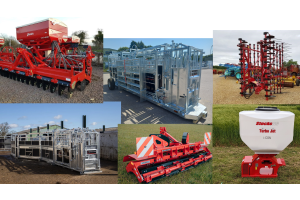Making The Case for Direct Drilling

My mother is a farmer’s wife, not a farmer – therefore the technical details of arable farming tend to alienate her. These days, she bemoans the grievous shortage of perfect and faultlessly arrayed ploughed fields, without realising that this time-honoured practice could become drastically outdated for modern use.
Of course, her judgement of direct drilling and minimum tillage is based on purely visual concerns. The image of a ploughed field harks us back to centuries past, in which by the labour of our own noble hands we ‘worked the land’. Ploughing became good sport, it even inspired a sandwich, but nowadays, its popularity seems to be dwindling (that is the plough, not the sandwich).

In past years, volatile cereal prices, high maintenance and labour costs, besides an increasing popularity for systems that are environmentally-friendly, have led farmers to seek out direct-drilling as a cost and energy-efficient practice. With ploughing, costs per hectare are high, and in autumn, when labour on farms is typically stretched already, the hours of the day required for perfect ploughing are simply not there. Ploughing, really, should only be used as a rotational tool, as opposed to a yearly institution. Ploughing is a good reset button, perhaps to seek weed control, when there is an infestation that needs inverting. Ploughing also helps to establish a straw-free seedbed or reduce compaction.
With the exceptionally dry summer of 2018, we can expect that, for a large part, direct drilling or minimum tillage cultivation will be used, as this results in minimal soil disruption and minimal loss of moisture. The Direct Drill maybe experiencing something of a revival Direct drilling’s popularity has as it encourages minimal soil disturbance, which doesn’t trigger blackgrass germination.
What’s more, stubble and straw cover, (as untidy as it may look) is good protection against water and wind erosion from the soil. Essentially, as a less rigorous cultivation system, direct drilling is a more environmentally sympathetic choice, as it favours soil preservation and health.
However, direct drilling should be avoided on particularly compacted, weedy or wet soils. Farmers using direct drilling techniques should be wary that crop residues on the soil surface can spread straw-borne diseases and increase slug population.
Probably the best advice we can give you is to use these methods in moderation, but so long as equipment and labour costs remain high, we predict that the use of the Direct Seed Drill and minimum tillage will be favoured, for typically better results (unfortunately for my Mum).
Here at Agri-Linc we will be happy to help with any direct drill machinery enquiries, see this page on the website for further details: https://www.agri-linc.com/farm-machinery/direct-drills.html. We are renowned suppliers of the original Moore UniDrill Direct Drills, and we often have Moore Direct Drills for sale and in stock as new machines as well as in our Used inventory. Our team wish you every success this Autumn, we are always glad to hear from you.






